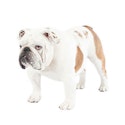Bulldog Dog Breed

- Size
- Medium
- Height
- 13 to 15 inches tall
- Weight
- Males: 50 pounds or more; Females: 40 pounds or more
- Coat
- Short
- Energy
- Low
- Activities
- Conformation, Obedience, Rally Obedience
Bulldogs are a popular breed known for their lovable disposition and charming wrinkles. Resolute and courageous, this breed is an excellent family companion, requiring minimal grooming and exercise.
Temperament
Bulldogs are friendly and courageous, with a happy disposition.
Characteristics
Bulldogs may look gruff, but these kind and courageous dogs make loyal companions.
Although the Bulldog isn’t toy-breed sized, their 50 pounds of wrinkles won’t stop them from curling up in your lap for a good cuddle. Though their mellowness can be mistaken for laziness, Bulldogs enjoy brisk walks and other activities.
Bulldogs are sweet, devoted and aim to please, making them fun to train. Many Bulldogs love to chew, so having plenty of tough toys is a must. They also enjoy games of tug-of-war.
Lifespan
8 to 10 years
Colors
Bulldogs’ color combinations range from red to white to fawn to fallow, or any combination of those. Their patterns and markings may include brindle, piebald, ticking, black masks, black tipping and a minimal amount of black in piebalds.
Shedding
Bulldogs require minimal grooming but do go through periods of heavy shedding. Perform an all-over brushing 2 to 3 times a week to keep them looking their best and keep his wrinkles clean and dry to avoid infection or irritation.
Health
Bulldogs are prone to overheating and should not be left out in the hot sun without access to shade and water.
Best Dog Food For Bulldogs
When it comes to choosing the best dog food for your Bulldog, it’s important to take his unique breed traits into consideration to maintain his ideal body composition.
Food for Bulldogs can include:
Best Dog Food For Bulldog Puppies
When choosing a food for your Bulldog puppy, remember puppies of any breed have specific nutritional needs during their time of development. A formula containing DHA nourishes brain and vision development and antioxidants support their developing immune systems to help them thrive during their first year of life.
The following foods meet the needs of a growing puppy:
- Beneful Healthy Puppy
- Purina Puppy Chow
- Purina One SmartBlend Healthy Puppy
- Purina Pro Plan Specialized Puppy
History
Bulldogs were created in the 13th century during King John’s reign in England. They were created for the “sport” of bullbaiting where a staked bull would fight a pack of dogs for spectator amusement. These ancient Bulldogs were a ferocious dog with huge jaws that appeared impervious to pain.
Finally, in 1835, the sport was banned and soon the Bulldog was crossed with other breeds to create the Bull Terrier, Staffordshire Bull Terrier and other bull-type terrier breeds for underground fighting. Bulldogs faced extinction, but admirers of the breed transformed them from fighter to companion. By 1886, the new Bulldog was recognized by the American Kennel Club.
The Bulldog is the national symbol of England, sharing similarities with the jowly, tenacious Prime Minister Winston Churchill.
Facts
- Presidential Bulldogs include Warren Harding’s “Oh Boy” and Calvin Coolidge’s “Boston Beans”.
- The Bulldog's name comes from the breed’s historical connection with bullbaiting, a popular medieval European sport (now illegal).
- He made his cartoon debut in the Hanna-Barbera animated film series, “Tom and Jerry” in 1942.
- Bulldogs originated in the British Isles and are also known as English Bulldogs.
- Yale was the first U.S. University to declare a mascot—the Bulldog—known throughout the school's history as “Handsome Dan.”
- University of Georgia also uses a Bulldog named “Uga” as their mascot. He sits in an air-conditioned doghouse on the sidelines at football games.
- The Bulldog is also the mascot for Mack Trucks and the Marine Corps.